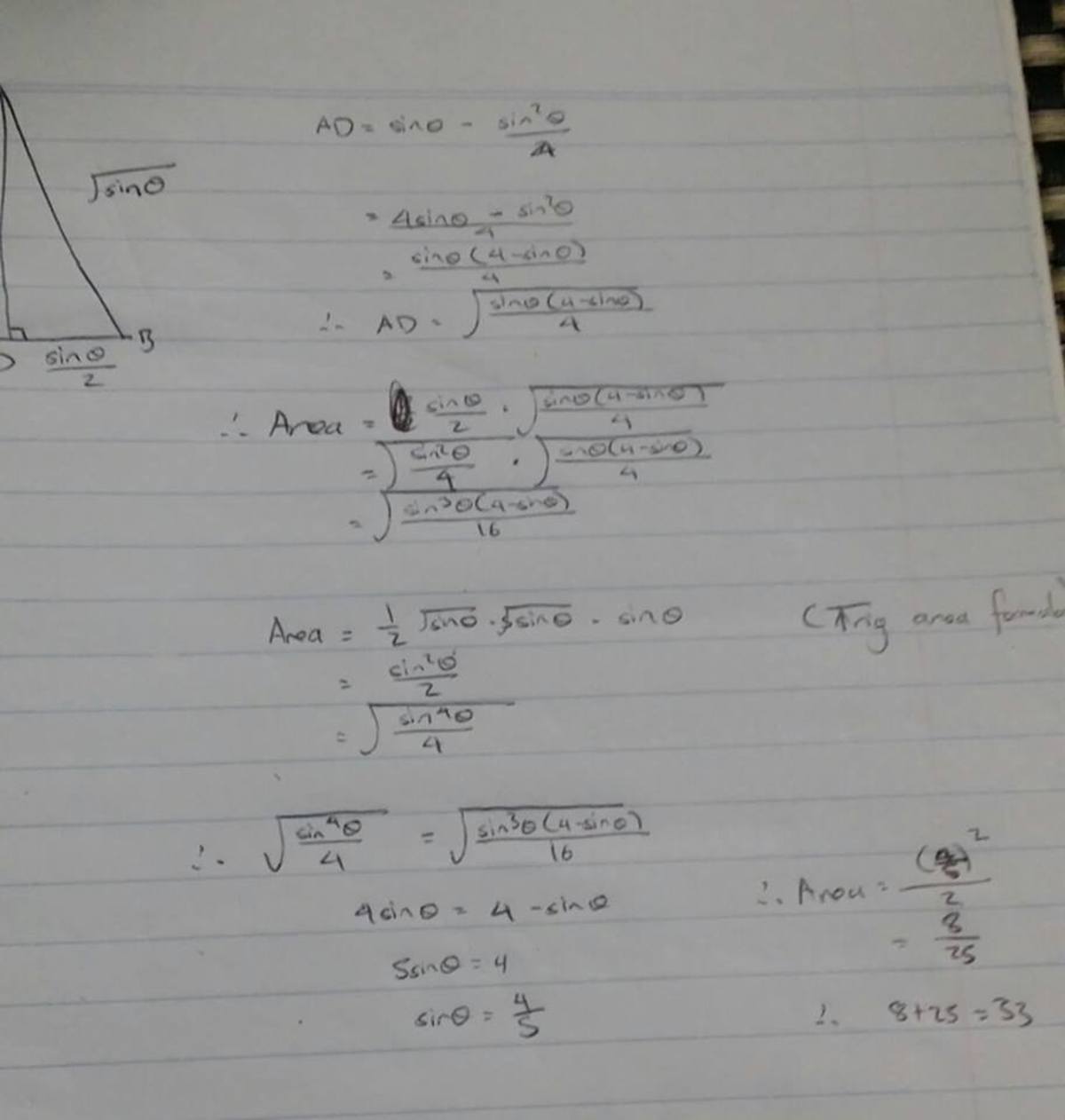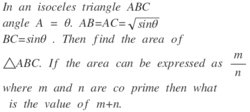This section requires Javascript.
You are seeing this because something didn't load right. We suggest you, (a) try
refreshing the page, (b) enabling javascript if it is disabled on your browser and,
finally, (c)
loading the
non-javascript version of this page
. We're sorry about the hassle.
4 solutions
In triangle ABC,
we have, BC=a= root (sin theta) AB=AC=b=c= sin (theta)
now we know that, cos(A)= (b^2+ c^2- a^2)/ 2bc as angle A= theta we have,
cos (theta) = 2sin(theta) - sin(theta)^2 / 2 sin(theta)
==> 2 sin (theta) cos (theta) = 2sin(theta) - sin(theta)^2 ==> sin(theta)^2 = 2 sin (theta) { 1 - cos(theta) } ==> sin(theta)^2 = 2 sin (theta) 2 sin(theta/2)^2 from further calculation we get,
tan (theta) =4/3 so sin(theta) =4/5.
now the area of triange ABC= 1/2. b. c. sin(A) = 1/2 sin(theta)^2 = 1/2 . 16/25 = 8/25
so, m+n =8+25 =33
I would be really grateful if anyone edited by comment in LATEX :)
OK.
I
n
△
A
B
C
,
w
e
h
a
v
e
,
B
C
=
a
=
sin
θ
A
B
=
A
C
=
b
=
c
=
sin
θ
.
n
o
w
w
e
k
n
o
w
t
h
a
t
,
cos
A
=
2
b
c
b
2
+
c
2
−
a
2
a
s
∠
A
=
θ
.
cos
θ
=
2
sin
θ
−
2
sin
θ
.
sin
θ
2
⟹
2
sin
θ
∗
cos
θ
=
2
sin
θ
−
(
sin
θ
)
2
⟹
(
sin
θ
)
2
=
2
(
sin
θ
)
(
1
−
cos
θ
)
⟹
(
sin
θ
)
2
=
2
(
sin
θ
)
∗
2
sin
2
θ
)
2
f
r
o
m
f
u
r
t
h
e
r
c
a
l
c
u
l
a
t
i
o
n
w
e
g
e
t
,
tan
θ
=
3
4
s
o
sin
θ
=
5
4
.
n
o
w
t
h
e
a
r
e
a
o
f
△
A
B
C
=
2
1
∗
b
∗
c
∗
sin
A
=
2
1
(
sin
θ
)
2
=
2
1
∗
2
5
1
6
=
2
5
8
s
o
,
m
+
n
=
8
+
2
5
=
3
3
.
I have rendered your solution in Latex. But I see many mistakes in it. To start with values of a and b=c are interchanged.
cos
θ
=
2
sin
θ
−
2
sin
θ
.
sin
θ
2
.
In fact I tried to understand your steps but failed. Sorry.

Why use trig when u can use algebra : ) Btw, that number that u can barely read just above the answer is (4/5).
First, we have that ∠ B = ∠ C = 2 π − 2 θ .
Next, using the Sine Law, we have that
sin ( θ ) sin ( ∠ B ) = sin ( θ ) sin ( θ ) ⟹ sin ( ∠ B ) = sin ( θ ) ⟹ cos ( 2 θ ) = sin ( θ ) .
Now square both sides and use the identity cos ( θ ) = 2 cos 2 ( 2 θ ) − 1 to find that
cos ( θ ) + 1 = 2 sin ( θ ) .
Square both sides again and use the identity sin 2 ( θ ) + cos 2 ( θ ) = 1 to find that
5 cos 2 ( θ ) + 2 cos ( θ ) − 3 = 0 ⟹ ( 5 cos ( θ ) − 3 ) ( cos ( θ ) + 1 ) = 0 .
The only valid solution in this case is thus cos ( θ ) = 5 3 , which in turn gives us that sin ( θ ) = 5 4 .
Δ A B C thus has side lengths 5 4 , 5 2 5 , 5 2 5 . A quick application of Heron's formula yields an area value of 2 5 8 .
Thus m = 8 , n = 2 5 and m + n = 3 3 .
use of the formula
Area of triangle= 2 1 a b sin θ
can be a better option here because we have sin θ where a,b are side lengths and θ is angle contained by them. Rest did the same.nice solution
it can also be solved by using sub-multiple angles.since the area is coming ((\sin\theta)^2)/2 & by solving the half of the base with respect to hypotenuse of triangle ABD where D is the mid point of side BC and AD is the altitude of triangle ABC we get \tan(theta)/2 = 1/2. since we know \sin\2*theta = (2\tan\theta)/(1+ (\tan\theta)^2).
S i n A = 2 ∗ S i n A / 2 ∗ C o s A / 2 . 2 1 S i n θ = 2 1 B C = A B ∗ S i n 2 θ . ⟹ 2 1 S i n θ = S i n θ ∗ S i n 2 θ . ∴ 2 1 = S i n θ S i n 2 θ = 2 ∗ C o s 2 θ . S i n 2 θ ∴ T a n 2 θ = 2 1 ⟹ S i n 2 θ = 5 1 , C o s 2 θ = 5 2 , ∴ S i n θ = 2 ∗ 5 1 ∗ 5 2 ∗ = 5 4 . A r e a o f t h e i s o s c e l e s Δ A B C = A B ∗ S i n 2 θ ∗ A B ∗ C o s 2 θ . = S i n θ ∗ 2 1 ∗ S i n θ = 2 1 ∗ ( 5 4 ) 2 = 2 5 8 = n m . m + n = 8 + 2 5 = 3 3 .
I lost, because of... 8+25~=~31 ???

Using Cosine Rule, we have:
B C 2 = A B 2 + A C 2 − 2 ( A B ) ( A C ) cos θ
⇒ sin 2 θ = 2 sin θ − 2 sin θ cos θ ⇒ sin θ = 2 − 2 cos θ
Squaring both sides, we have:
sin 2 θ = 4 − 8 cos θ + 4 cos 2 θ ⇒ 1 − cos 2 θ = 4 − 8 cos θ + 4 cos 2 θ
⇒ 5 cos 2 θ − 8 cos θ + 3 ⇒ ( 5 cos θ − 3 ) ( cos θ − 1 ) = 0
⇒ cos θ = 5 3 , since θ = 0 and hence cos θ = 1 .
Since cos θ = 5 3 ⇒ sin θ = 5 4 , as cos θ and sin θ as 3, 4 and 5 are Pythagorean triplets.
The area of △ A B C is given by:
A = 2 1 sin θ sin θ cos 2 θ = 2 1 × 5 4 × 5 4 × 2 cos θ − 1
= 2 1 × 5 4 × 5 4 × 2 5 3 − 1 = 2 1 × 5 4 × 5 4 × 5 4 = 2 5 8 = n m
⇒ m + n = 8 + 2 5 = 3 3